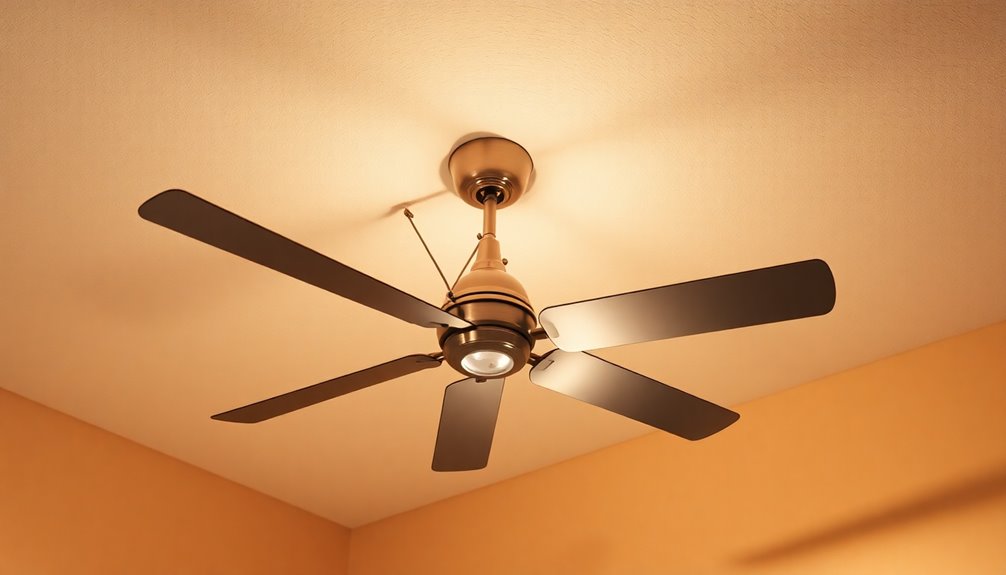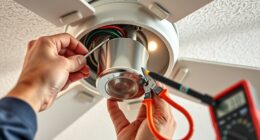Yes, you can replace ceiling fan blades to refresh its look and improve performance. Just verify the new blades match your existing fan's size to avoid any efficiency issues. It's essential to measure the blade length and securely remove the old blades using a screwdriver. When installing the new ones, make sure they're properly balanced to prevent wobbling. Keep in mind that replacement blades vary in cost and quality, so consider your options carefully. If you want to know more about selecting, installing, and maintaining fan blades, there's plenty more to explore.
Key Takeaways
- Yes, you can replace ceiling fan blades, but ensure they match the existing fan size and specifications for optimal performance.
- Measure the old blades carefully and retain screws for secure installation of the new blades.
- Select replacement blades of similar length and weight to prevent efficiency loss and potential motor strain.
- Regular maintenance, including cleaning and inspecting for imbalances, is essential to extend the life of new blades.
- Consider the costs of replacement blades versus investing in a new fan for long-term functionality and performance.
Choosing Replacement Fan Blades

Choosing replacement fan blades requires careful consideration to guarantee your ceiling fan operates efficiently and effectively.
You want to verify that the replacement blades match the size of your existing fan, typically ranging from 42 to over 60 inches in diameter. Using blades that are too long can strain the motor, while those that are too short won't provide the airflow you need.
It's also essential to select blades that are the same length as your original ones. Longer replacement blades can reduce motor efficiency and may even lead to overheating.
Pay attention to the weight and material of the new blades as well; heavier blades can increase the load on the fan motor, affecting its lifespan.
If you're replacing blades on an outdoor fan, don't forget to choose outdoor-rated blades to withstand harsher weather conditions.
Finally, check the compatibility with your existing mounting hardware. Different styles and designs may require new mounting arms or screws, so make sure you have everything needed for a secure installation.
Measuring Fan Blade Size
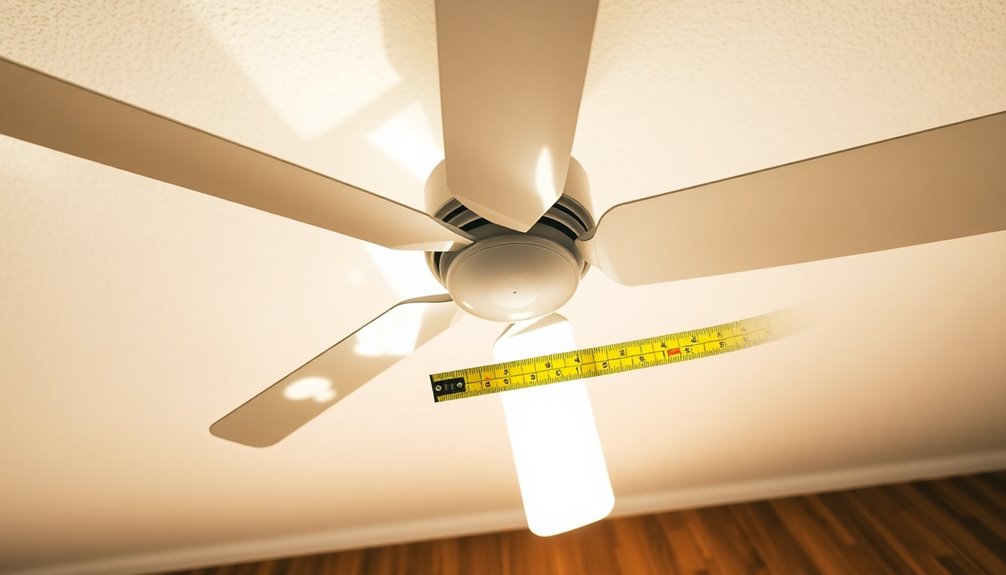
Accurately measuring your ceiling fan blades is vital for finding the right replacements. Start by safely accessing your fan with a ladder or stool. Make certain the blades are clean for better visibility.
Next, identify the attachment points by unscrewing one blade. Measure its length from tip to tip, and don't forget to keep the screws for reinstallation.
Common fan blade sizes range from under 42 inches to over 60 inches, with popular options being 42-inch and 52-inch blades. To verify you're replacing your ceiling fan blades correctly, it's important to match the size to your existing fan specifications. This helps avoid motor strain and guarantees maximum airflow performance.
Always check the fan box, manual, or warranty for the specified blade dimensions before purchasing replacements. By taking these steps, you'll make sure that the new blades fit perfectly and enhance your fan's efficiency.
Removing Old Fan Blades
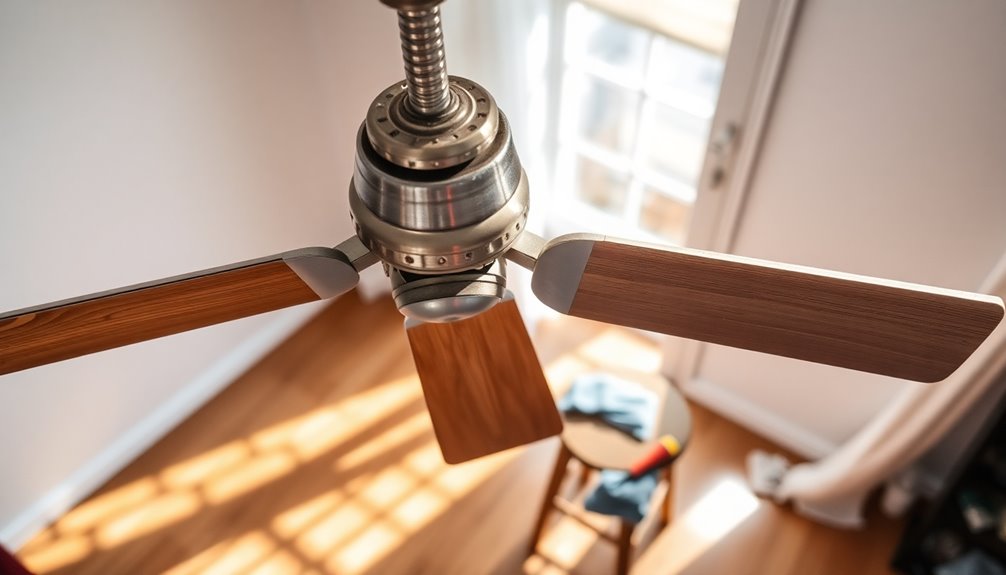
Before you start removing old fan blades, grab a ladder or step stool to reach the fan safely.
It's also a good idea to clean the blades for better visibility and to keep track of the screws during the detachment process.
As you take off each blade, remember to clean the fan housing to maintain its performance.
Necessary Tools Preparation
To safely remove old ceiling fan blades, you'll need to gather a few essential tools and prepare your workspace. Start by grabbing a sturdy ladder or step stool to access the fan comfortably. Make certain it's stable and positioned correctly. You'll also need a screwdriver, either Phillips or flathead, depending on your fan's design. A clean cloth is useful for wiping down the fan blades and housing before you begin, guaranteeing a clear view of any screws.
Here's a quick reference table for your tools:
| Tool | Purpose | Notes |
|---|---|---|
| Ladder/Step Stool | Access the ceiling fan safely | Guarantee stability and height |
| Screwdriver | Remove screws from fan blades | Check type (Phillips/flathead) |
| Clean Cloth | Wipe down fan blades and housing | Keep workspace tidy |
| Container/Bowl | Store screws safely | Prevent loss during removal |
| Clear Workspace | Avoid obstructions | Guarantee safety and efficiency |
With these tools ready, you're set for the next step in replacing the fan blades!
Blade Detachment Process
Once you've gathered your tools and prepared your workspace, it's time to focus on detaching the old fan blades. Start by using a ladder or step stool to safely reach the fan. Confirm there's a clear area beneath the fan for blade removal. Remember that the fan blades are attached with screws, so you'll need to unscrew each one carefully.
Here's a quick guide to make the process smoother:
- Retain the screws in a safe place for reinstallation.
- If needed, apply upward pressure while removing each blade to avoid damage.
- Inspect the fan housing for any dust accumulation after removing the blades.
As you unscrew, keep your workspace tidy by cleaning any dust off the blades beforehand. This way, you won't obstruct your vision during the removal process.
Once you've removed all the blades, take a moment to clean the fan housing to maintain its function. By following these steps diligently, you'll guarantee a hassle-free blade detachment process, setting you up perfectly for the next steps in your ceiling fan maintenance project.
Cleaning During Removal
Cleaning the fan blades during removal not only makes the process easier but also enhances safety by preventing dust and debris from obstructing your view. Before you start unscrewing the blades, grab a damp cloth or a gentle cleaning solution and wipe down each blade thoroughly. This cleaning step not only helps you handle the fan blades more easily but also guarantees a safer working environment.
While you're at it, make certain the area around the fan is clear of obstacles. This will give you easy access and prevent any accidents during the cleaning and removal process. Regularly cleaning the blades can prolong their lifespan and maintain peak airflow efficiency when you reinstall new ones.
Don't forget about the fan housing! Keeping it clean during the blade removal process can help avoid the buildup of dust that may affect the fan's performance in the future.
Installing New Fan Blades
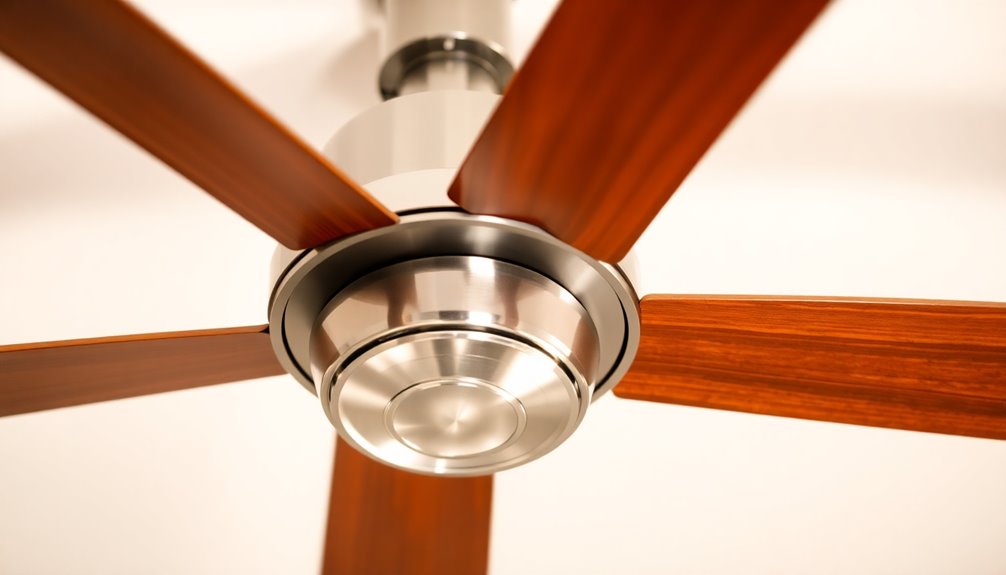
Installing new fan blades can rejuvenate your ceiling fan's performance and aesthetics, but it's crucial to confirm they meet the size and weight specifications of your existing blades. This guarantees you avoid motor strain and maintain peak performance.
Start by carefully unscrewing the old blades from the fan motor, taking note of the attachment points and retaining screws for the reinstallation process. Once you've removed the old blades, you can securely attach each new blade using the existing screws. Make sure they're fastened tightly to prevent any wobbling or awkward movement during operation.
Here are a few key steps to keep in mind while replacing your ceiling fan blades:
- Match the size and weight of the new blades to those you're replacing.
- Use the same screws for a secure fit.
- Regularly inspect and clean the blades after installation to extend their lifespan.
After installation, check the fan for any imbalances or unusual noises. If necessary, consider using a balance kit to stabilize the fan.
With these steps, you'll enjoy a smoothly operating ceiling fan that looks great!
Troubleshooting Common Issues

After replacing your ceiling fan blades, you might encounter some common issues that can affect performance. One of the most noticeable problems is grinding noises, which often indicate misalignment of the motor or blades. You'll want to inspect and possibly adjust the blade attachments to eliminate this sound.
If you notice drooping blades, it's likely due to wear or improper installation. Be certain to replace them with blades of the same size and weight to maintain ideal performance.
Inconsistent air movement can also arise from using incompatible replacement blades, which can hinder both the motor's functionality and the overall cooling efficiency of your fan. Regular maintenance is essential; cleaning and inspecting the blades helps prevent issues like wobbling or reduced airflow.
Lastly, don't forget to check the fan's rotation direction. Reversing the direction can greatly enhance airflow during hot months, maximizing your cooling efforts.
Cost Considerations for Replacement
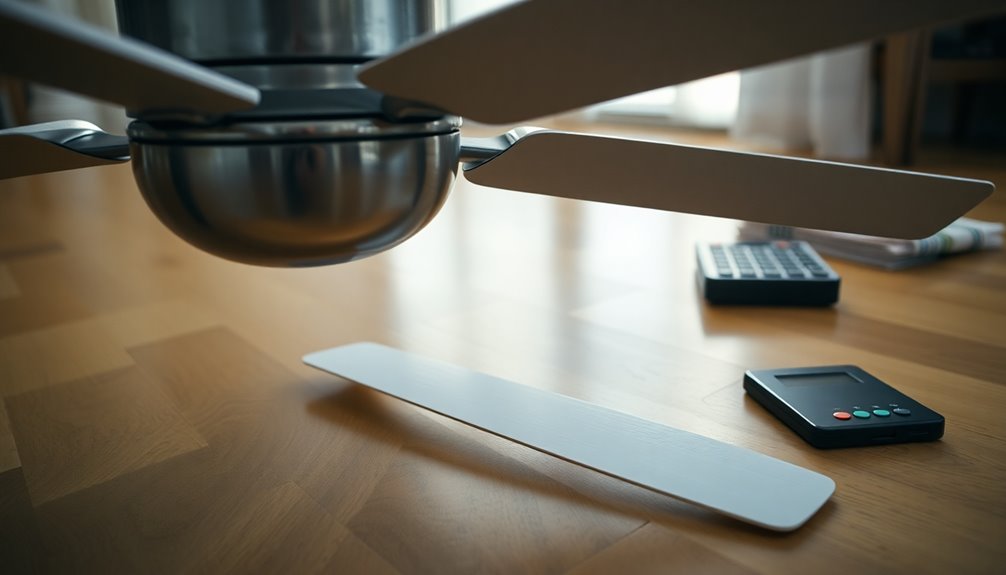
When considering replacement blade costs, you'll find prices ranging from about $12.80 to nearly $283.48, averaging around $50.
It's essential to analyze whether spending on new blades makes sense compared to investing in a new fan, especially if your current one is older or less efficient.
Replacement Blade Costs
Replacing ceiling fan blades can be a cost-effective solution, with prices typically ranging from $12.80 to $283.48.
On average, you can expect to spend around $50, but your specific costs will depend on the brand, material, and size of the blades you choose.
Here are some key points to ponder about replacement blade costs:
- Brand and Material: Premium brands like Fanimation Fans can push prices to the higher end, while budget-friendly options start at around $12.80.
- Size Variety: Blade lengths vary from 20.75 inches to 72 inches, impacting both your selection and costs.
- Potential Hidden Costs: Don't forget to factor in possible additional expenses, such as motor damage or installation fees, which may affect your overall cost-effectiveness.
Long-Term Investment Analysis**
Investing in replacement ceiling fan blades can seem like a smart choice initially, especially with costs averaging around $26 per fan. However, you should consider the long-term implications. While new blades can improve functionality, they may stress the motor, leading to potential damage that could negate any initial savings.
Here's a quick comparison of costs:
| Option | Estimated Cost |
|---|---|
| Replacement Blades | $26 |
| New Ceiling Fan | $100+ |
| Long-Term Maintenance | Variable |
| Installation of Longer Blades | Additional $30+ |
If you're thinking about longer blades, remember that installation might require new holes and balance kits, which can hike up costs. Over time, the reliability and performance of a new ceiling fan may outweigh the benefits of modifying your existing one. Hidden costs from motor damage can add up, making a new fan a more viable long-term investment.
Ultimately, weigh the ongoing maintenance of your current blades against the price of new ones or a new fan. This careful evaluation will help you make the best financial decision for your ceiling fan needs.
Frequently Asked Questions
How Much Does It Cost to Replace a Ceiling Fan Blade?
When you're looking to replace a ceiling fan blade, the cost can vary considerably.
You'll find replacement blades priced anywhere from $12.80 to $283.48, with an average around $50. The size and brand greatly influence the price, so it's important to evaluate what fits your fan.
If you opt for a bulk pack, you might save some money.
Don't forget to factor in potential installation costs if you need professional help!
Is It Cheaper to Repair or Replace a Ceiling Fan?
When deciding whether to repair or replace a ceiling fan, consider the overall costs.
You might find that replacing an outdated fan is more economical in the long run, especially if it's showing performance issues.
Repairs can add up, especially with installation costs.
Consult with professionals to get an accurate assessment of your situation. They can help you weigh the costs and benefits, ensuring you make the best decision for your needs.
Can You Replace a Broken Fan Blade?
Imagine a ship sailing smoothly, its sails in perfect harmony. If one sail tears, you can replace it, but you'll want to guarantee all sails are in sync.
Similarly, you can replace a broken fan blade, but it's essential to match the size and weight of the new blades. Always check the manufacturer's specs, and consider replacing all blades for balance.
This keeps your fan sailing smoothly and prevents any unwanted wobbling.
How to Find the Right Fan Blade Replacement?
To find the right fan blade replacement, start by checking the fan box, manual, or warranty for the specific blade dimensions.
You'll need to match the length and weight of the new blades to the originals to prevent overloading the motor.
Don't forget to take into account the mounting type and whether you need new hardware.
Finally, think about the materials, as they can affect durability and look, especially for indoor or outdoor use.
Conclusion
In the end, replacing your ceiling fan blades can breathe new life into your space, like a fresh coat of paint for your home's atmosphere. With the right tools and a bit of patience, you can easily swap out those old blades for a stylish upgrade. Just remember to measure carefully and follow the installation steps to avoid any hiccups. So, roll up your sleeves and give your fan a makeover—it's easier than you might think!





